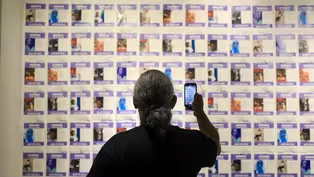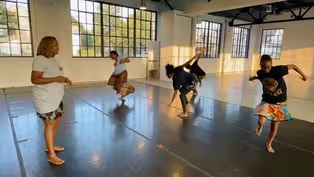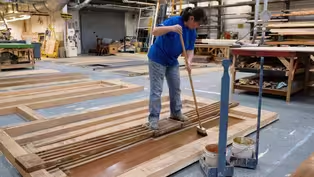Applause
Art Across Ohio: STEM Guitar Lab
Special | 8m 2sVideo has Closed Captions
The STEM Guitar Lab shows students and teachers alike the technology used to build electric guitars.
The sound of music now carries us to Dayton where guitar making is studied as a science. At Sinclair Community College, the STEM Guitar Lab shows students and teachers alike the technology used to build electric guitars. This story was produced by CET/ThinkTV and is part of our special series - Behind the Scenes: Art Across Ohio.
Problems playing video? | Closed Captioning Feedback
Problems playing video? | Closed Captioning Feedback
Applause is a local public television program presented by Ideastream
Applause
Art Across Ohio: STEM Guitar Lab
Special | 8m 2sVideo has Closed Captions
The sound of music now carries us to Dayton where guitar making is studied as a science. At Sinclair Community College, the STEM Guitar Lab shows students and teachers alike the technology used to build electric guitars. This story was produced by CET/ThinkTV and is part of our special series - Behind the Scenes: Art Across Ohio.
Problems playing video? | Closed Captioning Feedback
How to Watch Applause
Applause is available to stream on pbs.org and the free PBS App, available on iPhone, Apple TV, Android TV, Android smartphones, Amazon Fire TV, Amazon Fire Tablet, Roku, Samsung Smart TV, and Vizio.
Providing Support for PBS.org
Learn Moreabout PBS online sponsorshipMore from This Collection
Take a look behind the scenes of Ohio artists as they work.
Art Across Ohio: Urban Arts Space exhibition
Video has Closed Captions
Two artists in Columbus curate a show at the Ohio State University's Urban Arts Space (6m 47s)
Art Across Ohio: Djapo Cultural Arts Institute
Video has Closed Captions
Djapo Cultural Arts Institute in Cleveland creates new choreography. (8m 35s)
Art Across Ohio: Bowling Green State University Theatre
Video has Closed Captions
Kelly Mangan takes us behind the scenes of BGSU Theatre department. (5m 44s)
Providing Support for PBS.org
Learn Moreabout PBS online sponsorshipSTEM Guitar is a program that started out as a National Science Foundation grant that allows us as a team to teach teachers how to use the electric guitar as a vehicle to teach STEM topics to high school and middle school and even elementary school students.
It allows us to take the knowledge that we teach the teachers during the week of this training and they can take it back to their school and use the kits that are produced here at Sinclair that are really high quality kits.
So there's science, technology, engineering, mathematics, there's physics, there's so much stuff that can be kind of derived from this program.
We're not here to train luthiers.
We're trying to get a sophomore in Bozeman, Montana to understand that Mrs. Johnson's fifth grade geometry class has merit.
There's two components to the program.
There's an academic component that was funded under a National Science Foundation grant and that was the development of the curriculum.
The curriculum can be scaled from middle school, high school, community colleges as well as up to universities just depending on what it is that the students are studying.
The STEM Guitar Lab was formulated in order to supply guitar kits to the classes that are running those.
Sinclair has a unique place in the national STEM Guitar field because we are the production center for those kits.
We use the same curriculum to teach the class but we have the additional responsibility of making the kits and shipping them out all across the country.
STEM Guitar has shipped guitar kits to 48 states.
I think the only two states that we haven't hit yet is North and South Dakota.
They've even shipped some of the guitar kits overseas.
We sell kits to schools all over the United States including Pago Pago, American Samoa, Canada.
Our kits have gone down to Medellin, Columbia for outreach programs.
So without the Sinclair Guitar Lab there would be no STEM Guitar.
Here at the wood shop part of our facility it's just old fashioned woodworking to be honest.
We will get a truckload of raw lumber and we take those pieces and we'll cut them into what we call billets and they're different lengths for different parts.
So if I'm building bodies I will cut that board down into 22 inch long pieces and we'll stack them on the rack.
When that's complete then we'll start to assemble a body and we'll pull pieces off of the rack and then we will plane them to thickness and then we will joint those which is we will trim an edge so that it's at a 90 degree angle to the face that we just made so that when we glue them together they're glued together at a 90 degree angle and you get a nice flat board.
Those pieces are glued together.
We'll come back the next day, we'll take those pieces out, we will plane them to thickness again, we will then sand them to a specific thickness and then we'll put those in a stack and they will go over to the CNC lab across campus.
From the builder's standpoint in a workshop like this the very first thing they'll do is they will pick their bodies and their necks and their fretboards which is the playing surface on the front of the neck.
Shaping the guitar bodies would be second.
Attaching the fretboard to the neck and shaping the neck and getting the frets installed was another major milestone.
Getting the body all smoothed out and getting a clear finish applied to it to seal it and protect it is another major task.
Soldering and joining the electronics components is another major phase of the project.
Joining the body and the neck together and then populating the body with all the hardware would be next after that and then finally stringing the instrument up and doing the final setup and intonation to actually get it to translate from looking like a guitar to playing and functioning as a guitar should.
I like to pick that up at the end when it's all done and to kind of give it a test drive and see how it plays.
A lot of individuals think that and that's a common misconception in the engineering field and any field that you must know how to use something or play something, in this case playing guitar, a lot of individuals think that you must know how to do that in order to build it.
A common analogy that I like to use is the individuals that build the space shuttle, they don't know how to fly the space shuttle but they can put the space shuttle together.
The STEM guitar project is highly accessible at all levels and in terms of requisite academic knowledge will take all comers.
So wherever you are there are ways to make connections and so I wouldn't say you have to have had physics 101 in order to be able to be successful with this course and that's the great thing about STEM guitar is it's scalable so whatever your audience is you can take the materials that we provide and the process that we're showing and then make connections that are relevant to the students by saying here's an example in the guitar of XYZ topic that we need to cover in class this week.
Talking about math, science, social studies, we as educators have guidelines that we need to make sure students are you know hitting those guidelines at the end of the year but students have a hard time seeing those those goals and those aspirations that they need so it allowed me to build my other classes around this one model to make sure that students are understanding what they're learning when you see a student strum a guitar for the very first time that they built like you couldn't wipe the smile of their face with a you know with a fire hydrant this is so amazing.
I think we try to tell people that come through the program that play guitar is play with as many people as you can get plugged into where you can if you move to a new town and you can play guitar you can find friends really quick if you can fix a guitar you can find friends double quick.
We're about 15 to 17 years into the project the goal here is to continue to teach teachers no matter whether we're grant funded or not we want to allow people to keep this thing rolling and going down the line because it's such a great thing it's not just in Ohio so if you're watching this from California or Florida there's trainings potentially near you that you can come and take a part of.
I like knowing that my sphere of influence is larger than the small school that I'm at.
I like seeing the pride on people's faces when we complete at this week here at Sinclair as well as the students in classroom and in terms of the actual guitar process itself I really like all the quieter aspects of it like the fret work and working on the necks and everything to get the guitar to go from looking like an instrument toactually working like one.
Building a guitar is not it's not an everyday thing it's it's not I don't want to say it's not simple but if you pay attention if you ask questions then you'll be okay.
Every class at the end of the day if you walk in with ten fingers you walk out with ten fingers it's a good day.
Support for PBS provided by:
Applause is a local public television program presented by Ideastream


















